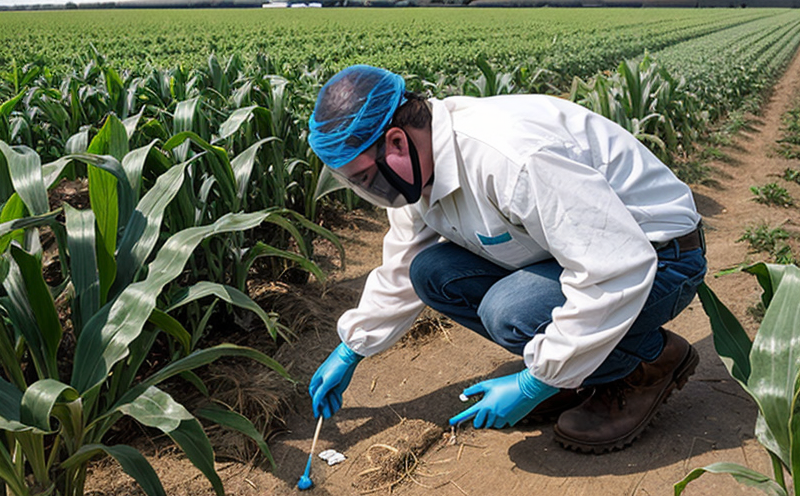Propiconazole Residue Testing in Crops
The need to ensure food safety and environmental protection has led to stringent regulations on pesticide residues. Propiconazole is a broad-spectrum fungicide used extensively in agriculture for the control of various fungal diseases, including leaf blight, powdery mildew, and scab. However, its presence in crops beyond safe limits can pose health risks to consumers.
Our laboratory offers specialized testing services for propiconazole residue in crops such as cereals (wheat, barley), fruits (apple, peach), vegetables (carrot, cucumber), nuts (almond), and oilseeds (rape). The testing process involves several critical steps: sample collection, extraction, purification, and quantification. Samples are collected from farms or storage facilities under strict conditions to avoid contamination. Extraction methods may vary depending on the crop type but typically involve solvent-based techniques.
Quantification is carried out using High-Performance Liquid Chromatography (HPLC) with Photodiode Array Detector (PDAD), which provides accurate and precise results. The limit of detection for propiconazole in crops can be as low as 0.1 ppm, ensuring compliance with international standards such as the Codex Alimentarius Commission (CAC). This ensures that consumers receive safe and high-quality produce.
Our laboratory adheres to ISO/IEC 17025 accreditation, ensuring that our testing processes meet stringent quality and reliability criteria. The results of these tests are reported promptly and in a clear format, providing actionable insights for producers and regulators alike. Compliance with international standards such as the Codex Alimentarius Commission (CAC), European Union Regulations, and U.S. Food and Drug Administration (FDA) guidelines is paramount to ensure that our services meet global expectations.
In addition to routine testing, we also offer research support for clients developing new formulations or improving existing ones. Our expertise lies in understanding the dynamics of pesticide residues within different crops and how they behave under various conditions. This knowledge allows us to provide tailored advice on best practices for minimizing residue levels while maintaining crop health.
Our laboratory uses state-of-the-art equipment and employs highly skilled personnel who are well-versed in all aspects of propiconazole residue testing. We maintain a clean, controlled environment to ensure accurate results, free from external interference or contamination.
Applied Standards
The testing for propiconazole residues follows internationally recognized standards such as ISO 17025, ASTM E1639-18, and EN 12492. These guidelines provide a framework for ensuring that the testing procedures are consistent across different laboratories worldwide.
ISO/IEC 17025: This standard sets out the general requirements for the competence of testing and calibration laboratories. It ensures that our laboratory maintains high standards of quality in all its operations.
ASTM E1639-18: This American Society for Testing and Materials (ASTM) standard provides a method for determining the residue levels of propiconazole in various types of foodstuffs. It specifies procedures for sample preparation, extraction, purification, and quantification.
EN 12492: This European Standard outlines the procedure for sampling and analysis of pesticide residues in agricultural products. Compliance with these standards ensures that our results are internationally acceptable and comparable.
The use of these standards guarantees that our testing methods are up-to-date, reliable, and consistent with global norms. This consistency is crucial for ensuring accurate detection and quantification of propiconazole residues in crops.
Quality and Reliability Assurance
We adhere to ISO/IEC 17025 accreditation standards, which ensure that our laboratory meets the highest quality and reliability criteria.
Our personnel undergo continuous training to stay updated on the latest testing methodologies and equipment.
The lab operates in a clean and controlled environment free from external interference or contamination.
We use state-of-the-art HPLC-PDAD equipment for accurate quantification of propiconazole residues.
Our commitment to quality is further reinforced by our rigorous internal audits and external peer reviews. These processes help identify any potential areas for improvement, ensuring continuous enhancement of our services. By maintaining these standards, we guarantee reliable and consistent results that can be trusted by all stakeholders involved in the agricultural sector.
International Acceptance and Recognition
The results from our laboratory are recognized and accepted globally due to adherence to international standards such as Codex Alimentarius Commission (CAC), European Union Regulations, and U.S. Food and Drug Administration (FDA) guidelines.
Our compliance with these regulations ensures that the testing services provided meet global expectations for food safety and quality.
The acceptance of our test results by regulatory bodies around the world makes us a trusted partner for businesses operating in international markets. Our expertise in propiconazole residue testing is not only confined to national borders but extends across continents, providing reliable data that supports global trade activities.





